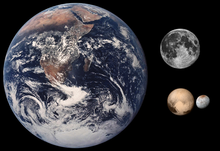Ҡояш системаһы/Плутон
Плутон — Ҡояш системаһындағы кәрлә планета. Плутонды 1930 йылдың 18 февралендә Ари зона астрономы Томбо Клайд аса.[1]
Плутондың ҙурлығы
[үҙгәртергә]
Плутондың массаһы яҡынса 12,500,000,000,000,000,000,000 килограмм.[2] Был бик ауыр күренә, әммә был Ерҙең массаһының ни бары 1/500 өлөшө. Плутондың диаметры 2200 - 2400 километр[3]. Планетаның өҫлөгө яҡынса 17,950,000 квадрат километр (йәки Ер өҫлөгөнөң 1/30 өлөшө)[4] Уның күләме 7,150,000,000 km3 (йәки Ер күләменең 1/150 өлөшө).[5].
Планетаның өҫтө нисек
[үҙгәртергә]
Планетаның өҫлөгө нисек икәнен беҙ асыҡ ҡына белмәйбеҙ. Әлегә космос караптары барып етмәгән (беренсе "Яңы горизонт" тигән космос карабы 2015 йылда Юпитер орбитаһын ғына үтте). Хатта иңяҡшы телескоптарҙан да планетаның өҫлөгөн ентекләп күреп булмай. Планетала бик һыуыҡ, -230 °C тирәһе.[6] Планета өҫлөгө боҙ менән ҡапланған.[7] Плутондың йоҡа ғына атмосфераһы бар, Ҡояштан алыҫлашҡан ваҡытта атмосфера туңа.[8]
Өҫтә уң яҡтағы фотола Плутондың төҫө күрһәтелгән.
What are Pluto's moons like?
[үҙгәртергә]Pluto has three known moons. The largest is called Charon. Charon is about half as wide as Pluto. Because Pluto and Charon are so close in size, they are sometimes called a "double planet".[9] Charon's surface is covered in water ice.[10] In Roman mythology, Charon took dead souls across the river Acheron to the land of the dead.[11] Two other moons were discovered in 2005. They have been named Nix and Hydra.[12]
How long is a day on Pluto?
[үҙгәртергә]One day on Pluto is about 6.487 Earth days long. Like Uranus, Pluto also spins on its side.[13]
How long is a year on Pluto?
[үҙгәртергә]One year on Pluto would be about 90,613 days or 248 years on Earth![14]
What is it made of?
[үҙгәртергә]Scientists believe Pluto is made mostly of rock and ice,[15] but they will not be sure until more research is done. The discovery of Charon helped scientists estimate the density of Pluto. The information collected told them what Pluto was and was not made out of. If Pluto were made out of heavy solids, it would have a very high density. If it were made of gases, it would have a low density. Pluto is somewhere in between, so it is probably made of rock and ice.
How much would Pluto's gravity pull on me?
[үҙгәртергә]If you were on Pluto, gravity would be only 0.06 times as strong as it is on Earth. [16] This means you could do really high jumps—even more than people could on the Moon!
Who is Pluto named after?
[үҙгәртергә]Pluto was named after the Roman god of the underworld. In Roman mythology, he kidnapped Proserpina (Persephone) so he could marry her. This made her mother, Ceres, the goddess of agriculture, very sad, causing winter. To end winter, Jupiter, the king of the gods and her brother, decreed that Proserpina could return to the surface as long as she hadn't eaten any food of the Underworld. However, she had eaten six pomegranate seeds, so Jupiter decided she had to spend six months in the underworld each year. This is the Roman myth of winter. When she goes to the Underworld, everything stops growing. When she comes back, her mother is happy again, and life returns. [17]
Is Pluto a planet?
[үҙгәртергә]Pluto has been officially classified as a dwarf planet, which is different from a regular planet. One of the reasons is that it is a lot smaller than other planets - although it is the tenth largest known object that revolves around the sun, it is smaller than many moons, including Earth's moon. Scientists used to think that Pluto was a lot larger than it actually is,[18] and it was thought of as the ninth planet for many years.
Another key reason is that Pluto is part of a large group of objects called the Kuiper Belt, which all revolve around the Sun in the area beyond Neptune. In January 2005 another object "Eris" was discovered in the Kuiper Belt. Eris is larger than Pluto. Scientists think there are even more Pluto-sized objects in this part of the solar system, as well as millions of smaller objects. Because of this, the International Astronomical Union (IAU) defined the term 'planet' for the first time. Under the definition, both Eris and Pluto (along with Ceres, Haumea and Makemake) are dwarf planets.
In spite of this, some people continue to hold on to the idea that Pluto is a regular planet because of tradition. Also, some textbooks and references are not up to date, and still list Pluto as the ninth planet.
References
[үҙгәртергә]- ↑ http://nssdc.gsfc.nasa.gov/planetary/factsheet/plutofact.html
- ↑ Snow, Theodore P. (1996) "The Outer Planets." In The Dynamic Universe: An Introduction to Astronomy. pp. 285. West Publishing Company. ISBN 0-314-64212-9; http://nssdc.gsfc.nasa.gov/planetary/factsheet/plutofact.html
- ↑ Spinrad, Hyron. 2004 "Pluto." World Book Online Reference Center. 2004. World Book, Inc. http://www.worldbookonline.com/wb/Article?id=ar435500; http://www.nasa.gov/worldbook/pluto_worldbook.html; Snow, Theodore P. (1996) "The Outer Planets." In The Dynamic Universe: An Introduction to Astronomy. pp. 285. West Publishing Company. ISBN 0-314-64212-9; http://amazing-space.stsci.edu/resources/fastfacts/pluto.php.p=Astronomy+basics@,eds,astronomy-basics.php&a=,eds
- ↑ http://nssdc.gsfc.nasa.gov/planetary/factsheet/plutofact.html
- ↑ http://nssdc.gsfc.nasa.gov/planetary/factsheet/plutofact.html
- ↑ http://nssdc.gsfc.nasa.gov/planetary/factsheet/plutofact.html; Snow, Theodore P. (1996) "The Outer Planets." In The Dynamic Universe: An Introduction to Astronomy. pp. 285. West Publishing Company. ISBN 0-314-64212-9; http://www.nasa.gov/worldbook/pluto_worldbook.html
- ↑ Snow, Theodore P. (1996) "The Outer Planets." In The Dynamic Universe: An Introduction to Astronomy. pp. 287. West Publishing Company. ISBN 0-314-64212-9; http://www.nasa.gov/worldbook/pluto_worldbook.html
- ↑ Snow, Theodore P. (1996) "The Outer Planets." In The Dynamic Universe: An Introduction to Astronomy. pp. 287. West Publishing Company. ISBN 0-314-64212-9; http://nssdc.gsfc.nasa.gov/planetary/factsheet/plutofact.html
- ↑ http://solarsystem.nasa.gov/planets/profile.cfm?Object=Plu_Charon
- ↑ http://seds.lpl.arizona.edu/nineplanets/nineplanets/pluto.html
- ↑ http://www.pantheon.org/articles/c/charon.html
- ↑ http://www.space.com/scienceastronomy/060621_nix_hydra.html
- ↑ http://nssdc.gsfc.nasa.gov/planetary/factsheet/plutofact.html; http://www.nineplanets.org/pluto.html
- ↑ http://solarsystem.nasa.gov/planets/profile.cfm?Object=Pluto&Display=Overview
- ↑ http://seds.lpl.arizona.edu/nineplanets/nineplanets/pluto.html
- ↑ Snow, Theodore P. (1996) "The Outer Planets." In The Dynamic Universe: An Introduction to Astronomy. pp. 285. West Publishing Company. ISBN 0-314-64212-9; http://nssdc.gsfc.nasa.gov/planetary/factsheet/plutofact.html
- ↑ http://www.windows.ucar.edu/tour/link=/mythology/persephone_seasons.html; http://www.pantheon.org/articles/p/persephone.html
- ↑ Sobel, Dava (2005) "The Planets." pp. 220. Harper Perennial Publishing Company. ISBN 1-84115-621-3

